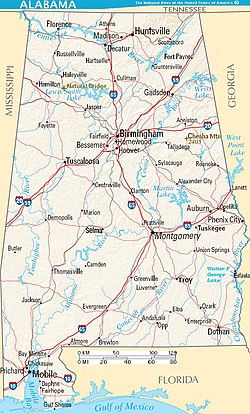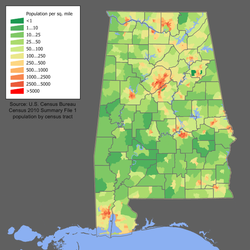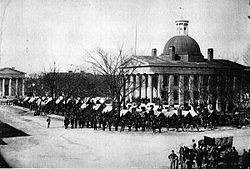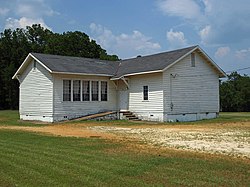Alabama
Alabama (/ˌæləˈbæmə/ ![]() Alabama (info • help)) is a state in the United States. Its capital city is Montgomery. The largest city is Huntsville. It became a state in 1819. Native American tribes such as Cherokee, Chickasaw, Choctaw, and Creek first lived in Alabama.
Alabama (info • help)) is a state in the United States. Its capital city is Montgomery. The largest city is Huntsville. It became a state in 1819. Native American tribes such as Cherokee, Chickasaw, Choctaw, and Creek first lived in Alabama.
|
| |
|
| |
| Anthem: "Alabama" | |
 Map of the United States with Alabama highlighted | |
| Country | United States |
| Before statehood | Alabama Territory |
| Admitted to the Union | December 14, 1819 (22nd) |
| Capital | Montgomery |
| Largest city | Huntsville |
| Largest metro | Greater Birmingham |
| Government | |
| • Governor | Kay Ivey (R) |
| • Lieutenant Governor | Will Ainsworth (R) |
| Legislature | Alabama Legislature |
| • Upper house | Senate |
| • Lower house | House of Representatives |
| U.S. senators | Tommy Tuberville (R) Katie Britt (R) |
| U.S. House delegation | 5 Republicans 2 Democrats (list) |
| Area | |
| • Total | 52,419 sq mi (135,765 km2) |
| • Land | 50,744 sq mi (131,426 km2) |
| • Water | 1,675 sq mi (4,338 km2) 3.2% |
| • Rank | 30th |
| Elevation | 500 ft (150 m) |
| Highest elevation | 2,413 ft (735.5 m) |
| Lowest elevation | 0 ft (0 m) |
| Population (2020) | |
| • Total | {{{2,000Pop}}} |
| • Rank | 24th |
| • Rank | 27th |
| • Median household income | $52,000[3] |
| • Income rank | 46th[4] |
| Language | |
| • Official language | English |
| • Spoken language | As of 2010[update][7]
|
| Time zones | |
| Entire state (legally) | UTC– 06:00 (Central) |
| • Summer (DST) | UTC– 05:00 (CDT) |
| Phenix City area (unofficially) | UTC– 05:00 (Eastern) |
| • Summer (DST) | UTC– 04:00 (EDT) |
| USPS abbreviation | AL |
| ISO 3166 code | US-AL |
| Trad. abbreviation | Ala. |
| Latitude | 30°11' N to 35° N |
| Longitude | 84°53' W to 88°28' W |
| Website | alabama |
| Alabama state symbols | |
|---|---|
 | |
 | |
| Living insignia | |
| Amphibian | Red Hills salamander |
| Bird | Yellowhammer, wild turkey |
| Butterfly | Eastern tiger swallowtail |
| Fish | Largemouth bass, fighting tarpon |
| Flower | Camellia, oak-leaf hydrangea |
| Horse breed | Racking horse |
| Insect | Monarch butterfly |
| Mammal | American black bear |
| Reptile | Alabama red-bellied turtle |
| Tree | Longleaf pine |
| Inanimate insignia | |
| Beverage | Conecuh Ridge Whiskey |
| Colors | Red, white |
| Dance | Square dance |
| Food | Pecan, blackberry, peach |
| Fossil | Basilosaurus |
| Gemstone | Star blue quartz |
| Mineral | Hematite |
| Rock | Marble |
| Shell | Johnstone's junonia |
| Slogan | Share The Wonder, Alabama the beautiful, Where America finds its voice, Sweet Home Alabama |
| Soil | Bama |
| State route marker | |
 | |
| State quarter | |
 Released in 2003 | |
| Lists of United States state symbols | |
Geography

Alabama is the thirty-first largest state in the United States with 52,419 square miles (135,760 km2) of total area. 3.18% of the area is water, making Alabama twenty-third in the amount of surface water, also giving it the second-largest inland waterway system in the United States. About three-fifths of the land area is a plain with a general downward slope towards the Mississippi River and the Gulf of Mexico. North Alabama has mostly mountains, with the Tennessee River cutting a large valley creating many creeks, streams, rivers, mountains, and lakes.
The states bordering Alabama are Tennessee to the north; Georgia to the east; Florida to the south; and Mississippi to the west. Alabama has a coastline at the Gulf of Mexico, at the very southern edge of the state. Alabama ranges in height from sea level at Mobile Bay to over 1,800 feet (550 m) in the Appalachian Mountains in the northeast. The highest point is Mount Cheaha, at a height of 2,407 feet (734 m). Alabama's land has 22 million acres (89,000 km2) of forest or 67% of the total land area. Baldwin County is the largest county in the state in both land area and water area.
Climate
The state is classified as subtropical Cfa under the Köppen climate classification. The normal yearly temperature is 64 °F (18 °C). Temperatures are often warmer in the southern part of the state because it is closer to the Gulf of Mexico, while the northern parts of the state, mostly in the Appalachian Mountains in the northeast, tend to be slightly cooler. Most of the time, Alabama has very hot summers and mild winters with lots of rain throughout the year. Alabama receives an average of 56 inches (1,400 mm) of rainfall annually and enjoys a lengthy growing season of up to 300 days in the southern part of the state.
Summers in Alabama are among the hottest in the United States, with high temperatures averaging over 90 °F (32 °C) throughout the summer in some parts of the state. Alabama also gets many tropical storms and rarely hurricanes. Areas of the state far away from the Gulf of Mexico can still feel the effects of the storms, which often dump big amounts of rain as they move inland and weaken.
Population
The number of people who live in Alabama was 5,024,279 on April 1, 2020, This is 244,543 more people living in the state than in 2010.[8] This includes the migration of 104,991 people into the state.
The top countries of origin for immigrants were Mexico (27 percent of immigrants), China (6 percent), India (6 percent), Guatemala (5 percent), and Germany (5 percent).[9]
Economy
According to the United States Bureau of Economic Analysis, the 2008 total gross state product was $170 billion, or $29,411 per capita. In 1999, the per capita income for the state was $18,189.
Alabama's agricultural outputs are poultry and eggs, cattle, plant nursery items, peanuts, cotton, grains (such as corn and sorghum), vegetables, milk, soybeans, and peaches. Although known as "The Cotton State", many reports say that Alabama is between eight and ten in national cotton making, with Texas, Georgia, and Mississippi making up the top three.
Alabama's company outputs are iron and steel products (like cast-iron and steel pipe); paper, lumber, and wood items; mining (mostly coal); plastic things; cars and trucks; and apparel. Alabama also makes aerospace and electronic products, mostly in the Huntsville area. Huntsville also has the Redstone Arsenal.
Education
Primary and secondary education
Public primary and secondary education in Alabama is under the review of the Alabama State Board of Education as well as local oversight by 67 county school boards and 60 city boards of education. Together, 1,479 schools have education for 743,012 elementary and secondary students.[10]
Colleges and universities
Alabama's programs of higher education are 14 four-year public universities, two-year community colleges, and 17 private, undergraduate and graduate universities. In the state are two medical schools, University of Alabama at Birmingham and University of South Alabama, two veterinary colleges, Auburn University and Tuskegee University, a dental school, University of Alabama, an optometry college, two pharmacy schools, Auburn University and Samford University, and several law schools, Birmingham School of Law, Cumberland School of Law, Miles Law School, and the Thomas Goode Jones School of Law. Public, post-secondary education in Alabama is overseen by the Alabama Commission on Higher Education. Colleges and universities in Alabama offer degree programs from two-year associate degrees to 16 doctor level programs.
Government
The Governor of Alabama is Kay Ivey.[10] The Lieutenant Governor is Will Ainsworth. The Chief Justice of the Alabama Supreme Court is Sarah Hicks Stewart. Both the Governor and Lieutenant Governor are members of the Republican Party.
Notable people from Alabama
- Nat King Cole, singer (Montgomery)
- Rosa Parks, Civil Rights Activist (Tuskegee)
- Helen Keller, (Tuscumbia)
- Bobby Eaton, pro wrestler (Huntsville)
- Mia Hamm, soccer star (Selma)
- Harold E. Martin, newspaperman (Montgomery)
- Scott Oden, writer (Somerville)
- Spooner Oldham; songwriter, keyboardist (Center Star)
- Stanley O'Neal, chairman & CEO of Merrill Lynch (Roanoke)
- Osceola, Seminole leader (Tallassee)
- Randy Owen, lead singer- Alabama (Fort Payne)
- Jesse Owens, track and field athlete (Oakville)
- Terrell Owens, American football player (Alexander City)
- Condoleezza Rice, former U.S. Secretary of State (Birmingham)
- Jimmy Wales, Wikipedia founder (Huntsville)
Alabama Media
The Moundville Archaeological Site in Hale County. It was occupied by Native Americans of the Mississippian culture from 1000 to 1450 CE.
The main house, built in 1833, at Thornhill in Greene County. It is a former Black Belt plantation.
Union Army troops occupying Courthouse Square in Huntsville, following its capture and occupation by federal forces in 1864
The former Mount Sinai School in rural Autauga County, completed in 1919. It was one of the 387 Rosenwald Schools built in the state.
Ono Island in Baldwin County
Monte Sano State Park in Huntsville
Related pages
| Wikimedia Commons has media related to Lua error in Module:Commons_link at line 62: attempt to index field 'wikibase' (a nil value).. |
References
- ↑ Elevation adjusted to North American Vertical Datum of 1988.
- ↑ "Cheehahaw". NGS data sheet. U.S. National Geodetic Survey. http://www.ngs.noaa.gov/cgi-bin/ds_mark.prl?PidBox=DG3595. Retrieved October 20, 2011.
- ↑ 2.0 2.1 "Elevations and Distances in the United States". United States Geological Survey. 2001. Archived from the original on October 15, 2011. Retrieved October 21, 2011.
- ↑ "US Census Bureau QuickFacts". Archived from the original on March 13, 2022. Retrieved April 30, 2022.
- ↑ "Median Household Income by State 2022". Archived from the original on September 7, 2022. Retrieved August 4, 2022.
- ↑ "State of Alabama". The Battle of Gettysburg. Archived from the original on July 13, 2014. Retrieved July 21, 2014.
- ↑ "Oxford English Dictionary". www-oed-com. Oxford University Press. Retrieved September 30, 2020.
- ↑ Stephens, Challen (October 19, 2015). "A look at the languages spoken in Alabama and the drop in the Spanish speaking population". AL.com. http://www.al.com/news/index.ssf/2015/10/a_look_at_the_drop_in_foreign.html. Retrieved September 21, 2016.
- ↑ Bureau, US Census. "Alabama Population Grew 5.1% Since 2010, Surpassing 5 Million". Census.gov. Retrieved September 1, 2023.
- ↑ https://www.americanimmigrationcouncil.org/sites/default/files/research/immigrants_in_alabama.pdf
- ↑ 10.0 10.1 "Governor". Office of the Governor of Alabama. Retrieved September 1, 2023.










